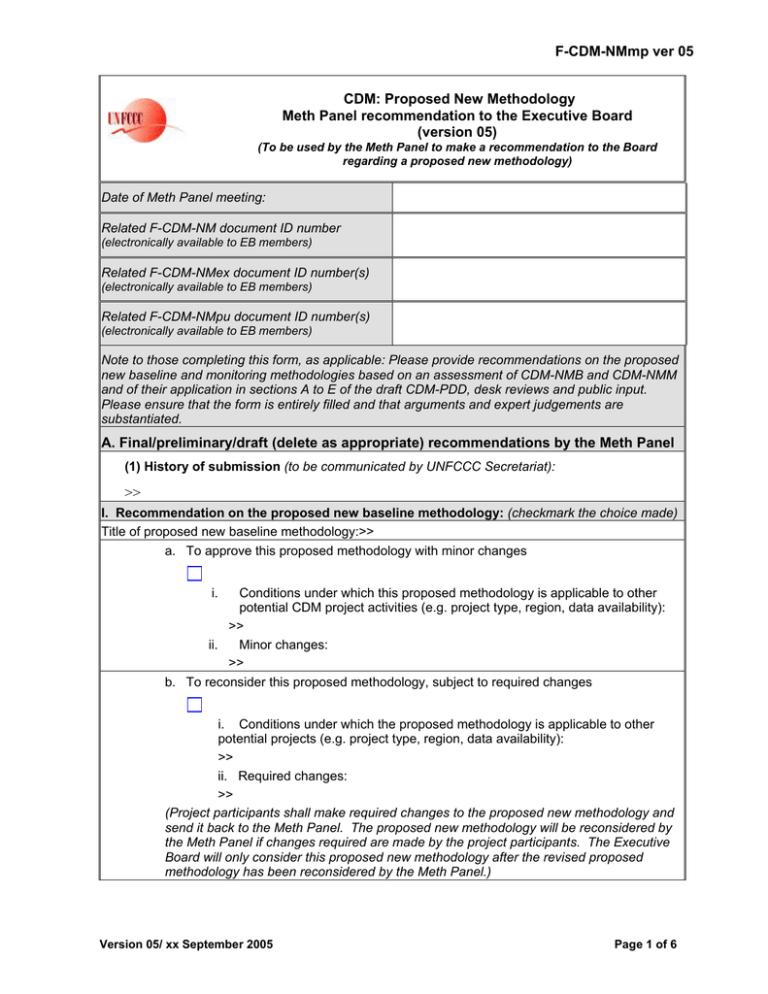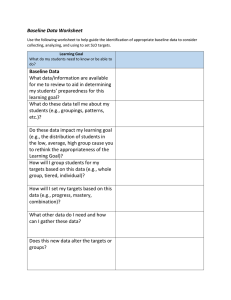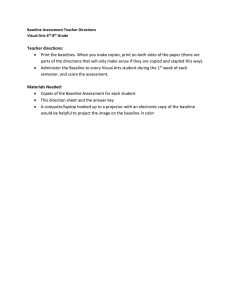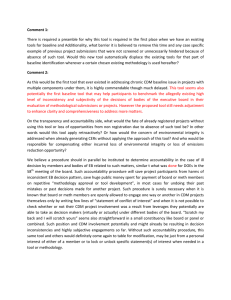F-CDM-NMmp ver 05 A. Final/preliminary/draft (delete as
advertisement

F-CDM-NMmp ver 05 CDM: Proposed New Methodology Meth Panel recommendation to the Executive Board (version 05) (To be used by the Meth Panel to make a recommendation to the Board regarding a proposed new methodology) Date of Meth Panel meeting: Related F-CDM-NM document ID number (electronically available to EB members) Related F-CDM-NMex document ID number(s) (electronically available to EB members) Related F-CDM-NMpu document ID number(s) (electronically available to EB members) Note to those completing this form, as applicable: Please provide recommendations on the proposed new baseline and monitoring methodologies based on an assessment of CDM-NMB and CDM-NMM and of their application in sections A to E of the draft CDM-PDD, desk reviews and public input. Please ensure that the form is entirely filled and that arguments and expert judgements are substantiated. A. Final/preliminary/draft (delete as appropriate) recommendations by the Meth Panel (1) History of submission (to be communicated by UNFCCC Secretariat): >> I. Recommendation on the proposed new baseline methodology: (checkmark the choice made) Title of proposed new baseline methodology:>> a. To approve this proposed methodology with minor changes i. Conditions under which this proposed methodology is applicable to other potential CDM project activities (e.g. project type, region, data availability): >> ii. Minor changes: >> b. To reconsider this proposed methodology, subject to required changes i. Conditions under which the proposed methodology is applicable to other potential projects (e.g. project type, region, data availability): >> ii. Required changes: >> (Project participants shall make required changes to the proposed new methodology and send it back to the Meth Panel. The proposed new methodology will be reconsidered by the Meth Panel if changes required are made by the project participants. The Executive Board will only consider this proposed new methodology after the revised proposed methodology has been reconsidered by the Meth Panel.) Version 05/ xx September 2005 Page 1 of 6 F-CDM-NMmp ver 05 c. Not to approve the proposed methodology i. Reasons for non-approval: >> (A new proposal should be submitted in accordance with the procedures for submission and consideration of proposed new methodologies of the Executive Board.) II. Recommendation on the proposed new monitoring methodology: (checkmark the choice made) Title of proposed new monitoring methodology: >> a. To approve this proposed methodology with minor changes i. Conditions under which methodology is applicable to other potential projects (e.g. project type, region, data availability): >> ii. Minor changes: >> b. To reconsider this proposed methodology, subjected to required changes i. Conditions under which the proposed methodology is applicable to other potential projects (e.g. project type, region, data availability.): >> ii. Required changes: >> (Project participants shall make required changes in the proposed new methodology and send it back to the Meth Panel. The proposed new methodology will be reconsidered by the Meth Panel if changes required are correctly made by the project participants. The Executive Board will only consider this proposed new methodology after required changes proposed have been made and the revised proposed methodology has been reconsidered by the Meth Panel.) c. Not to approve the proposed methodology i. Reasons for non-approval: >> (A new proposal should be submitted in accordance with the procedures for submission and consideration of proposed new methodologies of the Executive Board.) B. General information on submitted proposed new methodology (1) Title of proposed new baseline methodology: >> (2) One sentence describing the purpose of the methodology. >> " This methodology is designed for projects that ……" (3) Summary description of baseline methodology. Short statements on each on how the proposed methodology: chooses the baseline scenario, demonstrates additionality, calculates baseline emissions, calculates project emissions, calculates leakage, calculates emission reductions. >> Version 05/ xx September 2005 Page 2 of 6 F-CDM-NMmp ver 05 (4) Title of proposed new monitoring methodology: >> (5) Summary description of the monitoring methodology. Short statements on each on how the proposed methodology monitors the baseline and project scenario and calculates leakage and emission reductions. >> (6) Relationship with approved or pending baseline and monitoring methodologies (if applicable). a) Does the proposed new methodology include part of an already-approved methodology or a methodology pending approval (see recent EB reports)? If so, please briefly note the relevant methodology reference numbers (AMXXXX or ACMXXXX), titles, and parts included. >> b) In particular, is the proposed new methodology largely an amendment or extension of an approved methodology? (i.e. the methodology largely consists of expanding an approved methodology to cover additional project contexts, applicability conditions, etc., and is thus largely comprised of text from an existing methodology) If so, indicate whether the amendments or extensions are appropriate, and explain why. >> c) Indicate whether , and explain how, any other approved methodology (not noted in response to the previous question) could currently, or with minor modifications, be used to calculate emission reductions from the project activity associated with the proposed new methodology. If so, please indicate the reference number and the parts of the methodology that would need modification. >> d) Please briefly note any significant differences or inconsistencies (baseline emission calculations, leakage methods, and boundary definitions, etc.) between the proposed new methodology and already-approved methodology of similar scope. >> e) To avoid potential repetition, feel free to provide one comprehensive answer here that covers questions a through d. >> C. Details of the evaluation of the proposed new methodology by the Meth Panel: I. Proposed new baseline methodology: >> (1) Determining the baseline scenario and demonstrating additionality: a) Explain the methodological basis for determining the baseline scenario, and whether this basis is appropriate and adequate. >> b) Explain whether the application of the methodology could result in a baseline scenario that reasonably represents the anthropogenic emissions by sources of greenhouse gases that would occur in the absence of the proposed project activity. >> c) State whether the documentation explains how, through the use of the methodology, it can be demonstrated that a project activity is additional and therefore not the baseline scenario. If so, what are the tools provided by the project participants? >> d) Explain whether the basis for assessing additionality is appropriate and adequate: >> (2) Methodological basis for calculating baseline emissions and emission reductions Version 05/ xx September 2005 Page 3 of 6 F-CDM-NMmp ver 05 a) Explain how the methodology calculates baseline emissions and whether the basis for calculating baseline emissions is appropriate and adequate: >> b) Explain how the methodology calculates project emissions and whether the basis for calculating project emissions is appropriate and adequate. >> (3) Definition of the project boundary related to the baseline methodology: a) State how the project boundary is defined in terms of: i) Gases and sources >> ii) Physical delineation >> b) Indicate whether this project boundary is appropriate: >> (4) State whether the proposed methodology is appropriate for the referred proposed project activity and the referred project context (described in Sections A - E of the draft CDMPDD and submitted along with CDM-NMB): >> (5) Key assumptions/parameters (including emission factors and activity levels), rationale, data sources and uncertainties: a) List the implicit and explicit key assumptions, and rationale for the methodology. Identify those, if any, which are problematic and explain: >> b) Give your expert judgement on whether the assumptions/parameters are adequate: >> c) Indicate which data sources are used and how the data are obtained (e.g. official statistics, expert judgement): >> d) Explain the vintage of data recommended (in relation to the duration of the project crediting period) and whether the vintage of data is appropriate, indicating the period covered by the data: >> e) Give your expert judgement on whether the data used are adequate, consistent, accurate and reliable: >> f) State possible data gaps: >> (6) Assessment of uncertainties: a) Provide an assessment of uncertainties given (e.g. in determining baseline scenario, data sources, key assumptions) >> (7) Leakage: a) State how the baseline methodology addresses any potential leakage due to the project activity: >> Version 05/ xx September 2005 Page 4 of 6 F-CDM-NMmp ver 05 b) Indicate whether the treatment for leakage is appropriate and adequate: >> (8) Transparency, “conservativeness” and consistency a) Indicate whether the baseline methodology is presented in a transparent way, and if not, what changes are suggested: >> b) Explain whether the baseline methodology is conservative, and if so, how: >> c) Explain whether the baseline methodology is internally consistent, and if not, highlight which sections are inconsistent: >> (9) State the baseline approach selected, indicate whether this is appropriate, and why. >> (10) Any other comments: a) State which other source(s) of information (i.e. other than documentation on this proposed methodology available on the UNFCCC CDM web site) have been used by you in evaluating this methodology. Please provide specific references: >> b) Indicate any further comments: >> II. Detailed recommendations on the proposed new monitoring methodology Evaluate each section of CDM-NMM. Please provide your comments section by section: (1) Indicate if this proposed monitoring methodology is compatible with the proposed baseline methodology described in CDM-NMB of the draft CDM-PDD, and if not, why. >> (2) Assessment of key assumptions/parameters: a) List the implicit and explicit key assumptions. Identify those, if any, which are problematic and explain: >> b) State whether the key assumptions are adequate, and whether they have been arrived at in a transparent manner: >> (3) Data sources and data quality: a) Give your expert judgement on whether the data sources and data quality used are adequate, consistent, accurate and reliable. If not, please explain. >> b) State possible data gaps: >> Version 05/ xx September 2005 Page 5 of 6 F-CDM-NMmp ver 05 (4) Leakage (please elaborate, if appropriate): >> (5) Quality assurance and control procedures (please explain): >> (6) Assessment of the description of the proposed methodology: a) State whether the proposed methodology has been described in an adequate manner: >> b) State whether the proposed methodology is appropriate for the referred proposed project activity and the referred project context (described in Sections A - E of the draft CDM-PDD and submitted along with CDM-NMM): >> (7) Any other comments: a) State whether any other source of information (i.e. other than documentation on this proposed methodology available on the UNFCCC CDM web site) has been used by you in evaluating this methodology. If so, please provide specific references: >> b) Indicate any further comments: >> Signature of Meth Panel Chair Date: / / …………………………………………….. (name) Signature of Meth Panel Vice-Chair …………………………………………….. (name) Date: / / Information to be completed by the secretariat F-CDM-NMmp doc id number Date when the form was received at UNFCCC secretariat Date of transmission to the EB Date of posting in the UNFCCC CDM web site Version 05/ xx September 2005 Page 6 of 6


